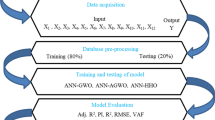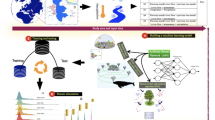Abstract
Recent studies have demonstrated the high efficiency of metaheuristic algorithms for various optimization engineering problems. The main focus of the present study is to apply a novel notion of stochastic search methods, namely evaporation rate-based water cycle algorithm (ER-WCA) to the problem of soil shear strength (SSS) prediction. The ER-WCA, as the name indicates, is a modified version of the water cycle algorithm that is used to computationally modify an artificial neural network (ANN) for the mentioned purpose. The sensitivity analysis showed that the most proper values for the number of rivers + sea and the population size are 5 and 300, respectively. The performance of the ER-WCA–ANN hybrid is compared to an ANN typically trained by the Levenberg–Marquardt algorithm to evaluate the effectiveness of the proposed metaheuristic technique. The findings showed that incorporation of the ER-WCA results in reducing the root-mean-square error by 5.87% and 4.92% in the training and testing phases, respectively. Meanwhile, the coefficient of determination rose from 84.27 to 86.11% and from 78.80 to 80.83% in these phases. It indicates that the weights and biases suggested by the ER-WCA can construct a considerably more reliable ANN. Therefore, the introduced method is recommended for practical uses in the early prediction of the SSS in civil engineering projects.










Similar content being viewed by others
References
Chen L-H, Li X, Xu Y, Chen Z-Y, Deng G (2019) Accurate estimation of soil shear strength parameters. J Cent South Univ 26:1000–1010
Weidinger DM, Ge L (2009) Laboratory evaluation of the Briaud compaction device. J Geotech Geoenviron Eng 135:1543–1546
Motaghedi H, Eslami A (2014) Analytical approach for determination of soil shear strength parameters from CPT and CPTu data. Arab J Sci Eng 39:4363–4376
Cai J-S, Yan E-C, Yeh T-CJ, Zha Y-Y, Liang Y, Huang S-Y, Wang W-K, Wen J-C (2017) Effect of spatial variability of shear strength on reliability of infinite slopes using analytical approach. Comput Geotech 81:77–86
Gao Y, Da S, Zhou A, Li J (2020) Predicting shear strength of unsaturated soils over wide suction range. Int J Geomech 20:04019175
Zhang Y, Zhong X, Lin J, Zhao D, Jiang F, Wang M-K, Ge H, Huang Y (2020) Effects of fractal dimension and water content on the shear strength of red soil in the hilly granitic region of southern China. Geomorphology 351:106956
Zhai Q, Rahardjo H, Satyanaga A, Dai G (2019) Estimation of unsaturated shear strength from soil–water characteristic curve. Acta Geotech 14:1977–1990
Moavenian M, Nazem M, Carter J, Randolph M (2016) Numerical analysis of penetrometers free-falling into soil with shear strength increasing linearly with depth. Comput Geotech 72:57–66
Moayedi H, Bui DT, Ngo T, Thao P (2019) Neural computing improvement using four metaheuristic optimizers in bearing capacity analysis of footings settled on two-layer soils. Appl Sci 9:5264
Moayedi H, Mehrabi M, Mosallanezhad M, Rashid ASA, Pradhan B (2018) Modification of landslide susceptibility mapping using optimized PSO–ANN technique. Eng Comput 35(3):967–984
Najafi-Ghiri M, Mokarram M, Owliaie HR (2019) Prediction of soil clay minerals from some soil properties with use of feature selection algorithm and ANFIS methods. Soil Res 57:788–796
Samui P (2019) Application of artificial intelligence in geo-engineering. In: Proceedings of international conference on inforatmion technology in geo-engineering
Ebrahimi M, Taleshi AA, Abbasinia M, Arab-Amiri A (2016) Two and three-dimonsional ERT modelling for a buried tunnel. J Emerg Trends Eng Appl Sci 7:118–127
Ebrahimi M, Moradi A, Bejvani M, Davatgari Tafreshi M (2016) Application of STA/LTA based on cross-correlation to passive seismic data, pp 1–5. https://doi.org/10.3997/2214-4609.201600018
Amani M, Amani P, Bahiraei M, Wongwises S (2019) Prediction of hydrothermal behavior of a non-Newtonian nanofluid in a square channel by modeling of thermophysical properties using neural network. J Therm Anal Calorim 135:901–910. https://doi.org/10.1007/s10973-018-7303-y
Mola-Abasi H, Eslami A (2019) Prediction of drained soil shear strength parameters of marine deposit from CPTu data using GMDH-type neural network. Mar Georesour Geotechnol 37:180–189
Jokar MH, Mirasi S (2018) Using adaptive neuro-fuzzy inference system for modeling unsaturated soils shear strength. Soft Comput 22:4493–4510
Qiao W, Huang K, Azimi M, Han S (2019) A novel hybrid prediction model for hourly gas consumption in supply side based on improved whale optimization algorithm and relevance vector machine. IEEE Access 7:88218–88230. https://doi.org/10.1109/ACCESS.2019.2918156
Qiao W, Yang Z, Kang Z, Pan Z (2020) Short-term natural gas consumption prediction based on Volterra adaptive filter and improved whale optimization algorithm. Eng Appl Artif Intell 87:103323. https://doi.org/10.1016/j.engappai.2019.103323
Qiao W, Yang Z (2020) An improved dolphin swarm algorithm based on Kernel Fuzzy C-means in the application of solving the optimal problems of large-scale function. IEEE Access. https://doi.org/10.1109/ACCESS.2019.2958456
Qiao W, Yang Z (2019) Forecast the electricity price of U.S. using a wavelet transform-based hybrid model. Energy. https://doi.org/10.1016/j.energy.2019.116704
Zhou G, Moayedi H, Foong LK (2020) Teaching-learning-based metaheuristic scheme for modifying neural computing in appraising energy performance of building. Eng Comput. https://doi.org/10.1007/s00366-020-00981-5
Zhou G, Moayedi H, Bahiraei M, Lyu Z (2020) Employing artificial bee colony and particle swarm techniques for optimizing a neural network in prediction of heating and cooling loads of residential buildings. J Clean Prod. https://doi.org/10.1016/j.jclepro.2020.120082
Shahsavar A, Khosravi J, Mohammed HI, Talebizadehsardari P (2020) Performance evaluation of melting/solidification mechanism in a variable wave-length wavy channel double-tube latent heat storage system. J Energy Storage 27:101063. https://doi.org/10.1016/j.est.2019.101063
Liu W, Zhang ZX, Fan JY, Jiang DY, Daemen JJK (2020) Research on the stability and treatments of natural gas storage caverns with different shapes in bedded salt rocks. IEEE Access 8:000507. https://doi.org/10.1109/ACCESS.2020.2967078
Zhang Z, Jiang D, Liu W, Chen J, Li E, Fan J, Xie K (2019) Study on the mechanism of roof collapse and leakage of horizontal cavern in thinly bedded salt rocks. Environ Earth Sci 78:292. https://doi.org/10.1007/s12665-019-8292-2
Qiao W, Yang Z (2019) Modified Dolphin swarm algorithm based on chaotic maps for solving high-dimensional function optimization problems. IEEE Access 7:110472–110486. https://doi.org/10.1109/ACCESS.2019.2931910
Qiao W, Yang Z (2019) Solving large-scale function optimization problem by using a new metaheuristic algorithm based on quantum dolphin swarm algorithm. IEEE Access 7:138972–138989. https://doi.org/10.1109/ACCESS.2019.2942169
Qiao W, Tian W, Tian Y, Yang Q, Wang Y, Zhang J (2019) The forecasting of PM2.5 using a hybrid model based on wavelet transform and an improved deep learning algorithm. IEEE Access 7:142814–142825. https://doi.org/10.1109/ACCESS.2019.2944755
Alnaqi AA, Moayedi H, Shahsavar A, Nguyen TK (2019) Prediction of energetic performance of a building integrated photovoltaic/thermal system thorough artificial neural network and hybrid particle swarm optimization models. Energy Convers Manage 183:137–148. https://doi.org/10.1016/j.enconman.2019.01.005
Hamid R, Mohammad HB, Mahdi A (2018) Reevaluation of SPT-based liquefaction case history using earthquake demand energy. In: Geotechnical earthquake engineering and soil dynamics V, Austin, Texas, 10–13 June 2018. https://doi.org/10.1061/9780784481455.047
Pourya K, Abdolreza O, Brent V, Arash H, Hamid R (2020) Feasibility study of collapse remediation of illinois loess using electrokinetics technique by nanosilica and salt. In: Geo-Congress 2020, Minneapolis, Minnesota, 25–28 February 2020. https://doi.org/10.1061/9780784482780.066
Baziar MH, Rostami H (2017) Earthquake demand energy attenuation model for liquefaction potential assessment. Earthq Spectra 33(2):757–780. https://doi.org/10.1193/030816EQS037M
Hemmat Esfe M, Bahiraei M, Hajmohammad MH, Afrand M (2017) Rheological characteristics of MgO/oil nanolubricants: experimental study and neural network modeling. Int Commun Heat Mass Transfer 86:245–252. https://doi.org/10.1016/j.icheatmasstransfer.2017.05.017
Khosravi R, Rabiei S, Bahiraei M, Teymourtash AR (2019) Predicting entropy generation of a hybrid nanofluid containing graphene–platinum nanoparticles through a microchannel liquid block using neural networks. Int Commun Heat Mass Transfer 109:104351. https://doi.org/10.1016/j.icheatmasstransfer.2019.104351
Moayedi H, Gör M, Lyu Z, Bui DT (2019) Herding Behaviors of grasshopper and Harris hawk for hybridizing the neural network in predicting the soil compression coefficient. Measurement. 152:107389
Nagaraju TV, Prasad CD, Murthy N (2020) Invasive weed optimization algorithm for prediction of compression index of lime-treated expansive clays. In: Soft computing for problem solving. Springer, Singapore, pp 317–324
Moayedi H, Tien Bui D, Dounis A, Ngo PTT (2020) A novel application of league championship optimization (LCA): hybridizing fuzzy logic for soil compression coefficient analysis. Appl Sci 10:67
Samui P, Hoang N-D, Nhu V-H, Nguyen M-L, Ngo PTT, Bui DT (2019) A new approach of hybrid bee colony optimized neural computing to estimate the soil compression coefficient for a housing construction project. Appl Sci 9:4912
Bui DT, Hoang N-D, Nhu V-H (2019) A swarm intelligence-based machine learning approach for predicting soil shear strength for road construction: a case study at Trung Luong National Expressway Project (Vietnam). Eng Comput 35:955–965
Moayedi H, Tien Bui D, Dounis A, Kok Foong L, Kalantar B (2019) Novel nature-inspired hybrids of neural computing for estimating soil shear strength. Appl Sci 9:4643
Nhu V-H, Hoang N-D, Duong V-B, Vu H-D, Bui DT (2019) A hybrid computational intelligence approach for predicting soil shear strength for urban housing construction: a case study at Vinhomes Imperia project, Hai Phong city (Vietnam). Eng Comput pp 1–14
Moayedi H, Bui DT, Ngo PTT (2020) Shuffled frog leaping algorithm and wind-driven optimization technique modified with multilayer perceptron. Appl Sci 10(2):689
Moayedi H, Bui DT, Anastasios D, Kalantar B (2019) Spotted hyena optimizer and ant lion optimization in predicting the shear strength of soil. Appl Sci 9:4738
Pham BT, Hoang T-A, Nguyen D-M, Bui DT (2018) Prediction of shear strength of soft soil using machine learning methods. CATENA 166:181–191
Pahnehkolaei SMA, Alfi A, Sadollah A, Kim JH (2017) Gradient-based water cycle algorithm with evaporation rate applied to chaos suppression. Appl Soft Comput 53:420–440
Sadollah A, Eskandar H, Bahreininejad A, Kim JH (2015) Water cycle algorithm with evaporation rate for solving constrained and unconstrained optimization problems. Appl Soft Comput 30:58–71
Fan J, Jiang D, Liu W, Wu F, Chen J, Daemen J (2019) Discontinuous fatigue of salt rock with low-stress intervals. Int J Rock Mech Min Sci 115:77–86. https://doi.org/10.1016/j.ijrmms.2019.01.013
Liu W, Zhang Z, Chen J, Fan J, Jiang D, Jjk D, Li Y (2019) Physical simulation of construction and control of two butted-well horizontal cavern energy storage using large molded rock salt specimens. Energy 185:682–694. https://doi.org/10.1016/j.energy.2019.07.014
Chen J, Lu D, Liu W, Fan J, Jiang D, Yi L, Kang Y (2020) Stability study and optimization design of small-spacing two-well (SSTW) salt caverns for natural gas storages. J Energy Storage 27:101131. https://doi.org/10.1016/j.est.2019.101131
Jinlong L, Wenjie X, Jianjing Z, Wei L, Xilin S, Chunhe Y (2020) Modeling the mining of energy storage salt caverns using a structural dynamic mesh. Energy 193:116730. https://doi.org/10.1016/j.energy.2019.116730
Hassoun MH (ed) (1995) Fundamentals of artificial neural networks. MIT Press, Cambridge
Anderson D, McNeill G (1992) Artificial neural networks technology. Kaman Sci Corp 258:1–83
Moré JJ (ed) (1978) The Levenberg-Marquardt algorithm: implementation and theory. Numerical analysis. Springer, Berlin, pp 105–116
Hecht-Nielsen R (1992) Theory of the backpropagation neural network. Neural networks for perception. Elsevier, Amsterdam, pp 65–93
Hornik K, Stinchcombe M, White H (1989) Multilayer feedforward networks are universal approximators. Neural Netw 2:359–366
Eskandar H, Sadollah A, Bahreininejad A, Hamdi M (2012) Water cycle algorithm—a novel metaheuristic optimization method for solving constrained engineering optimization problems. Comput Struct 110:151–166
S David (1993) The water cycle (John Yates, Illus). Thomson learning. New York
Luo Q, Wen C, Qiao S, Zhou Y (2016) Dual-system water cycle algorithm for constrained engineering optimization problems. In: Proceedings of the international conference on intelligent computing
Heidari AA, Abbaspour RA, Jordehi AR (2017) An efficient chaotic water cycle algorithm for optimization tasks. Neural Comput Appl 28:57–85
Guo Y, Li B-Z (2018) Novel method for parameter estimation of Newton’s rings based on CFRFT and ER-WCA. Signal Process 144:118–126
Moayedi H, Nguyen H, Foong LK (2019) Nonlinear evolutionary swarm intelligence of grasshopper optimization algorithm and gray wolf optimization for weight adjustment of neural network. Eng Comput. https://doi.org/10.1007/s00366-019-00882-2
Moayedi H, Nguyen H, Rashid ASA (2019) Novel metaheuristic classification approach in developing mathematical model-based solutions predicting failure in shallow footing. Eng Comput pp 1–8
Moayedi H, Gör M, Khari M, Foong LK, Bahiraei M, Bui DT (2020) Hybridizing four wise neural-metaheuristic paradigms in predicting soil shear strength. Measurement p 107576
Author information
Authors and Affiliations
Corresponding author
Rights and permissions
About this article
Cite this article
Foong, L.K., Moayedi, H. & Lyu, Z. Computational modification of neural systems using a novel stochastic search scheme, namely evaporation rate-based water cycle algorithm: an application in geotechnical issues. Engineering with Computers 37, 3347–3358 (2021). https://doi.org/10.1007/s00366-020-01000-3
Received:
Accepted:
Published:
Issue Date:
DOI: https://doi.org/10.1007/s00366-020-01000-3




